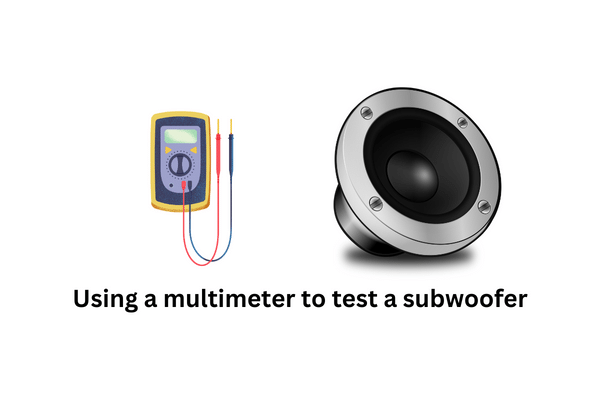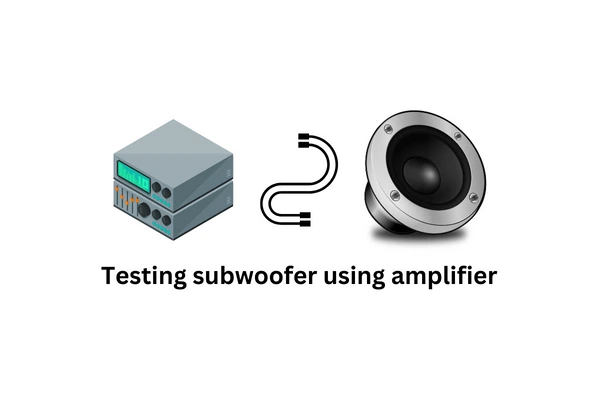How to Test a Subwoofer Without a Multimeter?

Suddenly, your subwoofer stops working. The first and foremost thing is to start testing your subwoofer. For this, you’ll need a multimeter. However, you don’t have it on purpose. If you don’t know how to test a subwoofer without a multimeter, the good news is that there are two ways to test it. Today, I will share the guide to check your sub without a multimeter. You can use an amp or a 9v battery in those two ways.
Let’s dive in to find out yours!
Is It Possible to Test Subwoofer Without a Multimeter?

As I mentioned above, the answer is Yes. However, it may not be as accurate or reliable to check the subwoofer without a multimeter, but it’s the easiest way to detect any fault in the subwoofer. Also, I suggest you get a multimeter to ensure an accurate reading to test a subwoofer. Anyway, testing the subwoofer without a multimeter involves checking both sound and power levels.
To check sound levels, you will need to listen for changes in sound compared to what is typical for the speaker. You can also determine the power levels by checking the amp meter on the back of the subwoofer. If there is any drop in power output, this indicates that something is wrong with the speaker, and you may need to fix it.
It is important to remember that a multimeter will still provide more accurate and reliable results than these non-invasive methods. Therefore, if you are looking for precise answers, it is recommended to use a multimeter to test your subwoofer.
2 Methods to Test a Subwoofer:
Look at the below two methods to test a subwoofer without a multimeter:
1. Using an Amp to Test the Subwoofer:

If you are having problems with your car subwoofer, you can use your car amplifier to detect the real reason behind the sound distortion. Otherwise, you can use any suitable amplifier. Follow these simple steps:
- Before you start, ensure you unplug the subwoofer from any power sources to prevent any damage to your audio system.
- Now make sure you have an appropriate amplifier and subwoofer connections. I will suggest you double-check the setup to prevent any misunderstanding.
- Now let’s turn on the amplifier by plugging the power source again and use any source for testing, such as an audio CD, Bluetooth, USB, or radio connection.
- Once you set it up, gently increase your system’s volume from lower to higher until you can hear audible bass sounds from your speakers, but it shouldn’t be so loud that it creates any mess.
- If you can hear a clear and loud bass, your subwoofer is working fine without any issues. If there is no audible frequency or the sound is faint, check all the connections to know if there are any wiring problems and restart the system. Ensure that your amplifier and subwoofer volume is average before testing again.
- Your subwoofer must have an issue if you cannot find any connection issues and still have problems after rechecking the setup.
- Once you are satisfied with the performance of your subwoofer and amplifier, reduce the volume to a comfortable level before disconnecting the system.
Finally, if you still have any doubts or concerns regarding testing a subwoofer without using a multimeter, consult a professional technician for help.
2. Using a 9V Battery:

The second option to test your subwoofer without a multimeter is by using a reliable 9V battery ⁽¹⁾. To perform the action, you will need to follow some simple steps:
- First, disconnect your subwoofer from any power source, such as the receiver or amplifier. Also, disconnect all the wires, such as audio cables, so you can freely remove your subwoofer from its enclosure.
- Now, take your subwoofer out of the chamber after unscrewing its nuts and bolts. Find the voice coil on the subwoofer and touch it with your fingertips to ensure it has no current.
- Take a 9V battery and connect it to the subwoofer’s positive and negative terminals, respectively. Now turn the battery on and check the coil is moving freely after touching it.
- If you cannot feel the vibration from the subwoofer’s voice coil, ensure that you use a fully charged battery and that the connections are correct.
- Now retest the subwoofer by taking your ears close to the speaker. Check if there is any sound coming from the sub. If you hear any sound from the subwoofer, it is working fine, and no further testing needs to be done.
- If you feel no sound or response from the voice coil after you’ve tested it with the 9V battery, there may be an issue with the sub. If that’s the case, you can consult with a professional.
General FAQs
How to Test Subwoofer With a Multimeter?
You can quickly test your sub using a multimeter. First, connect your subwoofer with a multimeter. Set the meter to Ohms and check the voice coil resistance level to determine whether the subwoofer is blown.
Can I Fix a Blown Subwoofer?
In some cases, yes. It depends on the cause of the issue and the damage done to the subwoofer. Often, you can replace the affected components easily if a fuse or driver has blown. However, if there is physical damage to the sub due to improper use, it may only be possible to do a permanent repair the sub by replacing the damaged component.
Final Words:
This is how to test a subwoofer without a multimeter. Still, I suggest you use a multimeter to get accurate results about your subwoofer. It’s hard to tell exactly what is causing the sound problem. If you have any questions or comments, let me know so I can help you with subwoofer testing.
